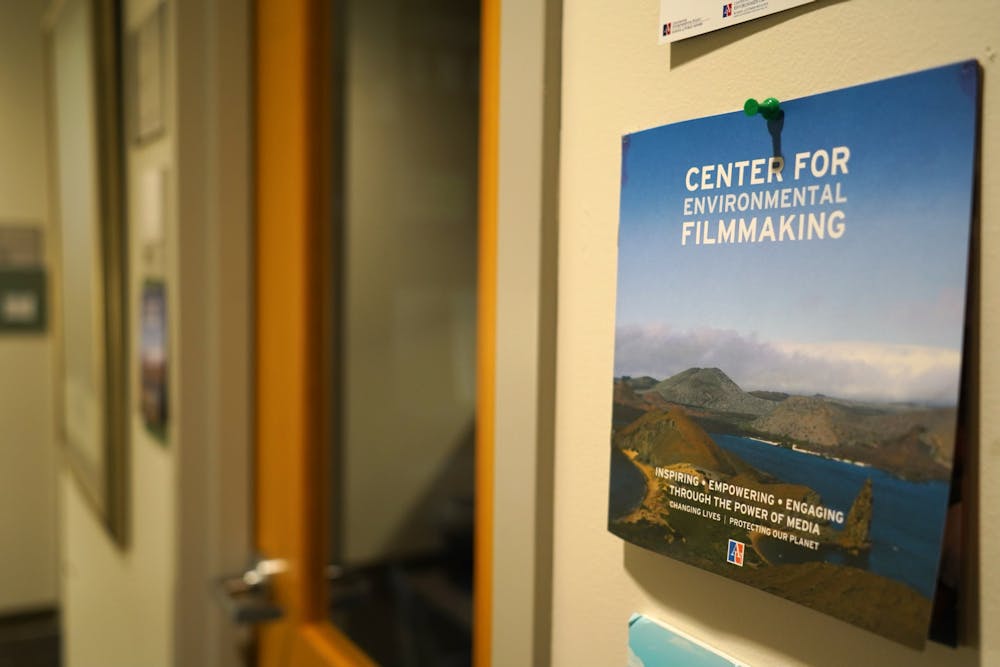From the Newsstands: This story appeared in The Eagle's December 2023 print edition. You can find the digital version here.
Communications and filmmaking both play an important role in the fight for environmental conservation and against climate change. American University’s own Center for Environmental Filmmaking brings students and faculty together to tackle these issues head on.
The Center for Environmental Filmmaking is just one of two environmental filmmaking graduate programs in the country. The Center is housed in the School of Communication and is focused on telling stories of environmental justice, racism, conservation and wildlife.
“Environmental and wildlife filmmaking is paying attention to who we are, in terms of who has the power to tell stories, and sharing that with those living in the environments and with the wildlife that we seek to make films about and to impact people in those places” said Larry Engle, the associate director of the Center and director of the Film and Media Arts division of SOC. “So we’re trying to share the storytelling methodology, the stories themselves, and I think that the Center for Environmental Filmmaking is at the forefront of that diversity and inclusivity.”
Engel has worked in environmental filmmaking for many years. Before coming to D.C., he ran a documentary production company with his brother in Manhattan, and worked on over 300 films.
“The power of story, especially when it comes to environmental issues, is of paramount importance for all of us on the planet, all of us,” Engel said.
May Livio, an associate director for the Center and an assistant professor in SOC, described the Center as a place for connecting with people and mobilizing them through environmental storytelling.
“The Center is very much concerned with informing the public, engaging the public, but especially sort of mobilizing and activating the public through environmental filmmaking,” Livio said.
She said students and faculty work together in the Center to achieve these goals and said that the Center is “working with students as well as faculty members to think about how to tell environmental stories in new ways and to actually do that.”
“They offer students unique opportunities to put themselves out there,” Amanda Dowd, a graduate student in the School of Communication, said. “In the environment, in the wild.”
Dowd also expressed her admiration for the Center and what it has been doing.
“I was really excited to learn about all their opportunities and the faculty that work there. And they are working really hard to bring attention to issues that we’re facing in real time.”
Executive Director Maggie Stogner has directed two films in recent years: “Upstream, Downriver” and “Unbreathable.”
“Upstream, Downriver” commemorated the 50th anniversary of the Clean Water Act. The Center partnered with local riverkeepers, the School of Public Affairs’ Center for Environmental Policy, the Clean Water for All consortium and others. The film focuses on water pollution and how it impacts marginalized communities.
The Center’s website says that “Upstream, Downriver” “provide[s] a catalyst for community engagement and action.”
“Unbreathable: The Fight for Healthy Air,” focuses on the ongoing struggle for clean air some face in the United States. It incorporates stories from people who are fighting for clean air and concentrates on asthma and the connection between air pollution and deaths from COVID-19.
Similarly to “Upstream, Downriver,” “Unbreathable” also addresses American legislation: the Clean Air Act.
The Center maintains green practices in the actual filmmaking process. SOC Graduate student and ambassador for the Green Film School Alliance Amy Young expanded on this.
“I think it’s a primary effort at American,” Young said. “We’re really hoping to kind of expand that and really push the importance of environmentally friendly filmmaking practices.”
Young explained that the components to making green film are twofold — the production element and the story behind the work being produced. “What we’re trying to push out at American is focusing more on those production friendly, green elements.”
Young said there are many ways filmmakers can cut down on pollution and carbon imprint, such as carpooling to sets, ensuring everybody is using reusable water bottles and using environmentally friendly materials and equipment.
“Everything sort of falls into the umbrella of being less wasteful on set,” Young said.
For students, participating in the Center for Environmental Filmmaking’s work is as simple as reaching out or taking a class. Engel said the easiest way for students to get involved is to email, call or text him and simply ask how they can help or work on current and developing projects.
“Students who are either filmmakers who are interested in environmental issues or environmentalists who are interested in filmmaking, or a combination of those things can interact with the Center through courses that are offered … through the Center,” Livio said.
“There are a couple of scholarships that the Center offers,” Livio said. “There are also experiential learning opportunities, field trips and other kinds of activities that are taken to learn how to film in the more human world.”
Looking to the future of the Center, Livio said that she would like to “look closely at what the conventions of environmental filmmaking have been, historically as well as sort of contemporary films. And to think through how to make new kinds of different environmental films that are definitely invested in justice.”
Engel agreed, with his own take as a professor and educator.
“I need to make films for us and the planet,” said Engel. “What I really enjoy doing is helping mentor students in the field.”
The Center offers students partnerships and collaborations with important organizations and figures in the field of environmental filmmaking, on top of the hands-on experience and multitude of courses. It also teaches students the ethics of wildlife conservation filmmaking and its best practices.
All of this is done in an effort to help students create films and other multi-format media about the environment, according to the Center’s website.
“Together, we create films that are catalysts for positive change.”
This article was edited by Bailey Hobbs, Soumya Sahay, Patricia McGee and Abigail Pritchard. Copy editing done by Isabelle Kravis, Sarah Clayton and Emilia Rodriguez.





